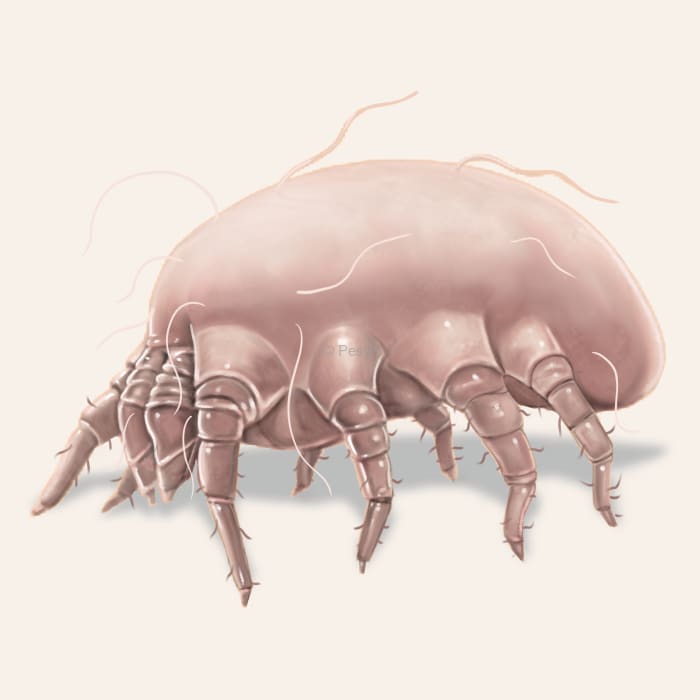How to identify and get rid of dust mites

Invisible critters that live on dust and float in the air
Imagine tiny critters living everywhere, all over your home. But since you can’t see them, you’d never know they were there!
Why?
Because dust mites are so small, you would need a microscope to see them. They could be living in your beds, carpets, or furniture.
Don’t worry too much. These harmless mites don’t bite or sting, but they can cause problems if you have allergies or asthma. If they become too prevalent in your home, they can cause rashes or respiratory issues.
Dust mites eat the dead skin cells we shed every day. These skin cells, along with insect parts and other tiny bits, make up the dust in our homes.
The few grams of skin cells you shed can feed over a million dust mites!
How to identify dust mites
Unfortunately, dust mites cannot be seen with the naked eye. You would need a microscope to spot these little guys.
Even though you may not be able to see them, they can still make their presence known in a big way—especially if you start experiencing more allergy symptoms like sneezing, runny nose, or itchy eyes while indoors.
These tiny pests love to settle into soft surfaces like mattresses, pillows, carpets, and upholstery, where they feed on dead skin cells. If your allergies seem worse in the morning or when sitting on upholstered furniture, it might be a sign that dust mites are around.
How big are dust mites?
Dust mites are incredibly small, measuring only about 1/100 of an inch.
What other pest looks like a dust mite?
While you won’t be confusing dust mites by their appearance, it can be difficult to determine what is causing you to have an allergic reaction or respiratory issue. Some people mistake rashes for bedbug bites or other insect bites.
If you suspect you are having an allergic reaction to dust mites, consult with a healthcare professional or have an allergy test done.
Where do dust mites live?
Dust mites can be found in homes across the entire United States, thriving anywhere there is dust and a bit of humidity.
They prefer to live inside near humans or pets and are commonly found on pillows, mattresses, or upholstered furniture.
How to get rid of dust mites
Dust mites have been living with us since we settled into permanent residences. That being said, it may be nearly impossible to completely eliminate dust mites from your home. However, it is possible to reduce the abundance of dust mites where you live and eliminate health concerns.
Here are a few tips to get you started:
- Reduce humidity: Keep indoor humidity below 50% to make the environment less hospitable to dust mites.
- Frequent washing: To kill dust mites, wash bedding, curtains, and other fabrics in hot water at least once a week.
- Vacuum and dust regularly: Use a vacuum cleaner with a HEPA filter to reduce dust and remove mites from carpets and furniture. Dust blinds, furniture crevices, and other dusty objects in your home.
- Use allergen-proof covers: Encase mattresses, pillows, and duvets in allergen-proof covers to prevent dust mites from colonizing.
- Replace carpeting: If you are struggling with dust mites after thoroughly cleaning, consider removing your carpet in exchange for different flooring.
- Use air filters: Dust mite particles can hang in the air for a long time, often hours. HEPA filters can remove those particles from the air, reducing your allergy symptoms.
Treat dust mites with Pestie
If you're still having trouble keeping dust mites away, the best option is to use a pro-grade, effective pest control solution like Pestie.
Pestie is a do-it-yourself pest control solution that's specially designed to keep dust mites and other pests away from your home.
With Pestie, you can rest easy knowing that your living space is protected and free of creepy crawlies. And the best part? It's designed for people, pets, and the planet, so you can say goodbye to harsh chemicals and hello to peace of mind!
- Save hundreds compared to traditional annual pest plans
- People, pet, and planet-friendly
- Pro-grade customized formulas
Quick facts
How dangerous are Dust Mites?
Medium danger risk
Dust mites are not dangerous, but their body fragments and feces can trigger allergies and asthma in sensitive individuals.
- Scientific name
Family - Pyroglyphidae
- Other common names
American House Dust Mites, European House Dust Mites
- Colors
Translucent white or light tan
- Life span
65-100 days
- Diet
Dead skin cells
Dust mites don’t need to drink water to survive. They absorb water from the air! That’s why they need to live in places with high enough humidity. Without it, they get thirsty and die!








